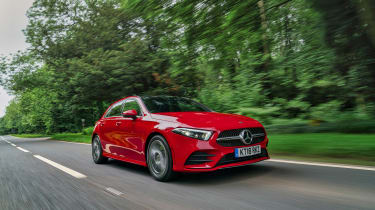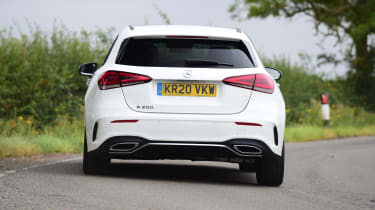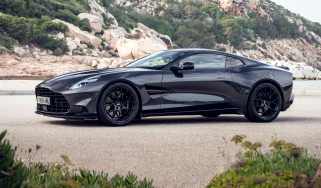Mercedes-Benz A-class review – ride and handling
Now in its fourth generation, the Mercedes A-class is unrecognisable from the car that kicked things off two decades ago.
The old A-class always rode poorly, so it’s disappointing to find the latest model is little better. The multi-link cars are more adept at dealing with broken and rough road surfaces than the torsion beam models lower down the range which clonk and shudder more readily, but on the AMG Line’s 18-inch wheels and 40-profile tyres, both setups feel unsettled on all but the smoothest surfaces, rumbling noisily over patchy tarmac and thudding over harsher bumps.
This firmness does translate to good body control and roll is kept to a minimum, backed up by strong levels of lateral grip. The steering is reasonable too, with a responsive and well-weighted feel once past a slightly dead zone around the straight-ahead, and once you’re up to a decent speed and sending greater loads through the front axle. There’s a typical Mercedes slickness to the steering too, even if the suspension’s struggle to contain bumps sometimes sends vibrations through the rim.
With little feedback though the A-class lacks involvement, so there’s not much fun to be had slotting the A-class down a twisting section of road, even though it’s capable of doing so with speed and composure.
However, the A35 proves that there's actually a solid base underneath the A-Class. It's not perhaps as engaging and adjustable as a VW Golf R, but as a device to pick apart a twisting road it's very impressive. The steering is quick and accurate, if relatively low on road feel, but there's more substantial weighting than you'll find in the Golf, which is actually quite confidence-inspiring on unfamiliar roads.
There's plenty of turn-in bite, particularly in the dry when the grip feels near-endless There's also a feeling the front and rear axles are working together, giving the car a lovely four square stance. This isn't a Focus RS style oversteerer, but the four-wheel drive transmission's switch from front-wheel drive to 50-50 torque split is so quick (it's already priming the centre diff before you've got on the throttle) you can fire out of corners with your right foot buried without fear of falling off.
Body control is superb too. There's very little to choose between the Comfort, Sport and Sport+ driving modes in cars with adaptive dampers (even Comfort gets a little agitated over most surfaces), with the middle setting just about offering the best fast road compromise between comfort and composure. The brakes deserve special mention, offering both tireless stopping power and beautifully judged pedal progression.




